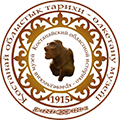A monument of residential architecture of Kazakhstan of the pre-revolutionary period.
A sample of Art Nouveau beginning . XX century. The author, the builder are unknown.
The building is one of the unique monuments of civil architecture of the early twentieth century.
It is one of the few examples of the so-called pure Art Nouveau preserved in Kazakhstan. This is a one-story, corner, two-facade brick house with risalites and an iron, multi-pitched roof. The towers of the parapet are interconnected by a decorative metal lattice. The windows are high with double glazing. The fate of the owner of this house is remarkable – one of the founders and the most prominent industrialists of the city, Fyodor Petrovich Kiyatkin. A native of a family of Mordovian migrant peasants, hardworking and enterprising Fyodor Kiyatkin graduated only from a parochial school, but in his youth he decided to become a rich man by all means. Starting with the construction of a windmill, he proved himself as a talented financier and entrepreneur.
F.P. Kiyatkin owned the largest highly mechanized steam mill in the city. By the way, the Kiyatkin family owned three of the five steam mills in the city. Subsequently, F.P.Kiyatkin participated in financing the construction of the first Troitsk– Kustanai railway, was chairman of the Board of the Kustanai branch of the Russian-Asian Commercial and Industrial Bank, a member of the City Duma. In 1916, he sold his businesses, stating that he wanted to retire, but "remain useful to society by lending to industry." After the revolution, Fyodor Petrovich considered it good to leave Kostanay. Until 1928, he never shunned any work, modestly worked as a carpenter. Then he returned to the city and got a job as a janitor and watchman at the local Collective farmer's House, by a curious coincidence, housed in the former and long-nationalized house of F.P. Kiyatkin. The townspeople were firmly convinced that it was no coincidence that the former rich man was working here and was probably going to secretly dig up his hidden treasures somewhere. But the treasure remained one of the urban legends, and Fyodor Petrovich Kiyatkin, who had experienced both ups and downs in his life, died peacefully in the summer of 1941, leaving a good memory of himself and the house, which still remains one of the most interesting architectural monuments of the city of Kostanay.
In 2010, the building was renovated without changing the architectural design. The wooden extension of the veranda adjacent to the building from the northeast side, which is not part of the monument, was dismantled.
Description of the monument
The dating of the monument is Con. XIX – beginning . XX centuries, 1911
Location, address: Kostanay, Tolstogo str., 40
The building is rectangular in plan, brick, one-story, on a ribbon foundation of rubble stone. The corner parts of the facade are accentuated by parapets. Moreover, the dominant is the southern corner part of the facade. The interpretation of the facades of the building, architectural elements is characteristic of the Art Nouveau style – these are the curved, ornate forms of the parapet on the southern facade, vertically elongated asymmetrical window openings. In the study of the planes of the walls, blades were used, rhythmically located between the window piers. Brick pillars on the roof of the building are like a continuation of the blades and perform not only a decorative function, but also a constructive one. Decorative elements of the facade, in addition to pilasters, are niches of rectangular shapes, which are located above and below the window openings, as well as on the basement of the building. The roof is gable, covered with roofing iron. The doors are paneled.
The layout of the building is corridor. The dimensions in the plan are 22 x 17 m. Height – 6 m. Construction volume – 3600 m3.








